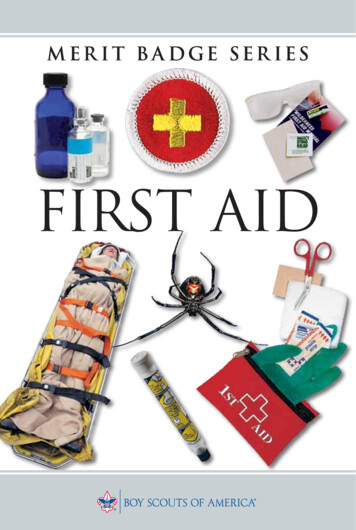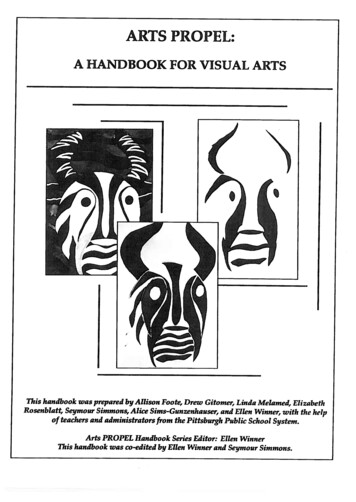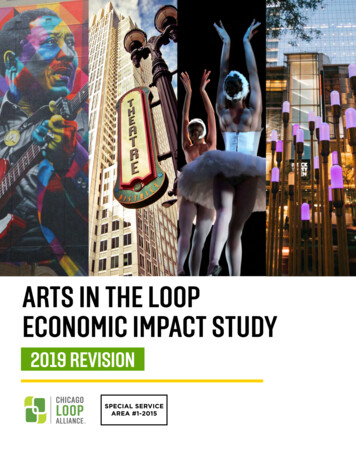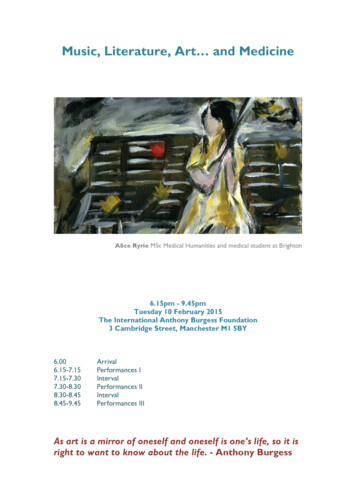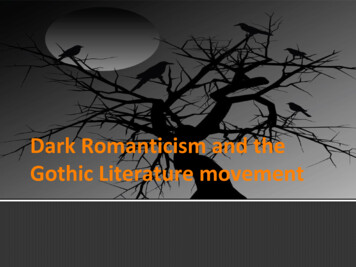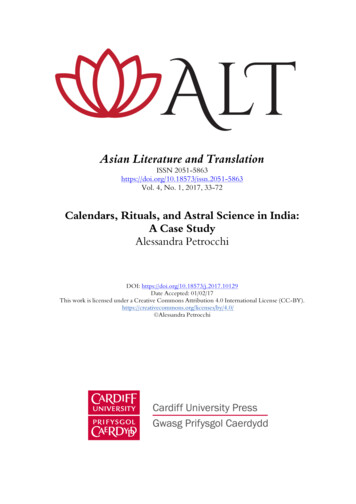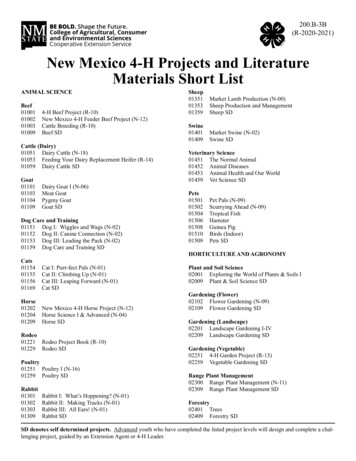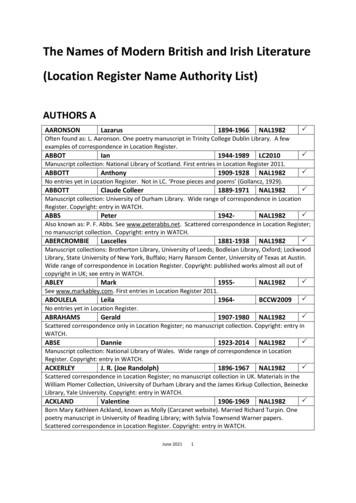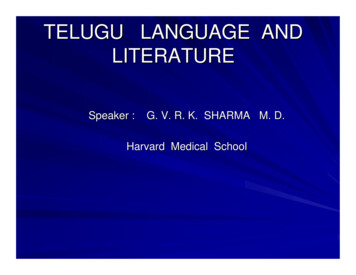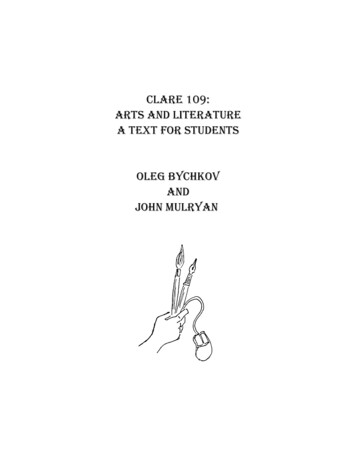
Transcription
CLARE 109:ARTS AND LITERATUREA TExT foR STUDENTSoLEg ByChkovANDJohN MULRyAN
ARTS AND LITERATURE2
ChAPTER oNE3ContentsChapter 15Chapter 212Chapter 322Chapter 427Chapter 538Chapter 645Chapter 752
ARTS AND LITERATURE4[Blanc]
ChAPTER oNE5Chapter 1.Introduction: the nature of art and aestheticsArt and emotionConceptual or verbal discourse is able to transmit information, not how you feel.Since each of us is a whole person, an “I,” and not just an intellect, it isimportant how we feel. Art affects you precisely as an “I” and makes you feelsomething, rather than transmitting some conceptual information. Art hasintellectual components, of course, but they are always enhanced by emotional.This is the point of art: to affect directly our sense perception and emotions. Thisis also why art is often more powerful than concepts and words. Due to itsnature art is also capable of training and controlling human emotions.Art and other areas of human lifeArt is something important, desirable, pleasurable, something people need andwant. Since art has to do with personal emotions, one can use art to draw onthese emotions for other reasons.For example, another thing that is important, pleasurable, and desirablefor humans is sex. What happens to sex in society? It is used as a commodity incommerce/business to sell products. It is used within the power structure eitherto obtain power or to enjoy and demonstrate power. It is used in religion sinceall religions regulate sexual behavior.The same thing happens with the arts. They are used in the same majorareas to enhance them: the arts sell (as a commodity or promotional tool); theyare used in connection with politics to promote agendas; they are used inconnection with religion to enhance religious experience.Art as art (art and the aesthetic sense; art and beauty)Art and aesthetic perception, or our sense of beauty, also have something to dowith cognitive functions and knowledge. For example, symmetry andproportion is importnat to many arts: just as in mathematics, physics orgeometry. Also the sense of what is appropriate (taste, style) or the sense ofbalance is important to the arts: just like in ethics where we strive for a balancedbehavior and what is appropriate.Another crucial area is the disinterested nature of our appreciation ofart, which is called the aesthetic attitude. By learning to view the arts in adisinterested manner (i.e., apart from any personal interest or gain), we alsolearn to transcend our personal interest in morals.Finally, art and beauty are important to enhance our sense oftranscendence. Art and beauty are immediately pleasing but the reasons for this
ARTS AND LITERATURE6are unclear. This means that the rules and principles of art are beyond us ortranscend us: possibly indicating the presence of a higher principle (e.g., thedivine) in the universe.Art and religionWhy study the arts and religion together?Historically most religious traditions—from aboriginal cultures to worldreligions—used the arts. At the same time, historically most of what we now call“art” were religious objects or depicted religious themes.Historically, both communities and private individuals invested inreligious art as if it were one of the most important enterprises. At the sametime, there were many religious controversies and even wars around art (untilthe present!), which resulted in mass destruction of art objects and even indeaths of their supporters.Human perception of the world is synaesthetic, i.e., not only languagefaculty is used but also vision, hearing, and other senses. Faculties such asvision, hearing and language are heavily interdependent, so there is no reason toprioritize only one of them.There is also evidence that areas other than language (i.e., vision andhearing, or traditional artistic media) can express certain part of our experience,such as religious, better and reach people at a deeper level.How the arts contribute to religionThe arts have always been used to express the divine, e.g., in Christian liturgicalservices. What is their role? Do they simply enhance certain texts, meanings,and feelings? Or are they essential to our perception of the divine? Indeed, ifreality has a divine origin then whatever is part of it must be germane or at leastanalogous to the divine.1. Generally, the arts, due to their strong emotional impact and abilityto act immediately and directly upon our perception, prior to conceptualthinking, can enhance any area of experience, including religious experience.2. Specifically, both natural and artistic beauty is capable of evokingwhat is called the sense of transcendence, or the presence of some deeper(divine) principles in the world. Art and beauty are immediately pleasing but thereasons for this are unclear. This means that the rules and principles of art arebeyond us or transcend us: possibly indicating the presence of a higher principle(e.g., the divine) in the universe.The arts are used for these purposes by most religious traditions, butspecifically in the Christian tradition by the Eastern Orthodox and Catholictraditions.
ChAPTER oNE7Tensions between the arts and religionHistorically, both of the above points also caused concerns about the use of thearts by religion.1. The strong emotional impact of the arts causes a concern that theaudience will simply be distracted by the beauty they perceive and focus on thearts themselves, not on the words of the scriptures, religious ideas or sentiments.This concern generated strong anti-artistic tendencies, especially in theProtestant tradition, some branches of which rejected visual arts altogether.2. The second concern is just how well the arts can represent the divineand what exactly they represent. According to some traditions, only the words(scriptures) and speech can convey correct dogmas and ideas about the nature ofGod, and the arts do it very imprecisely and vaguely and can simply “leadastray” instead of conveying the correct teaching. The traditions that for thisreason reject any visual arts, especially representational, are, e.g., Jewish andMuslim: see section on iconoclasm below.Principles Common to all of the ArtsAll art, through an appeal to one or more of the senses, conveys some type of animpression that elicits delight or pleasure from the audience. Thus art poses abrilliant solution to the problem of objectivity vs. subjectivity: the subject, theaudience, draws meaning and delight from the object, the work of art. Thatsubjective delight is based on objective principles of art inherent within theuniverse.All art is characterized by unity, coherence, and emphasis. The work ofart is a unified whole, its individual parts are related to each other, and theinterpretant is provided with clues as to what should be emphasized in thecomposition, a process called localization when applied to narrative art. Thus artpossesses integrity or wholeness, with all elements of the art form working toachieve a unified effect. Conversely, if a work of art were to disintegrate—say ifthe pages of a book were reassembled in no particular order or a statue weresmashed into a dozen unrelated pieces—we would be justified in saying that thework of art no longer existed. Thus every work of art is a composition,something new that has been created by assembling different parts in an orderlyfashion. And it has been fashioned by a maker, creator, author, or artist.An important universal principle in all arts is contrast that always has apredictable dramatic or disturbing impact, as opposed to uniformity. Severalother principles can be roughly classified under the category of contrast. Thepresence or lack of balance has either a calming or an unsettling effect. All artmakes use of both symmetry and asymmetry as organizing principles. Thuspleasant and unpleasant sound combinations play against each other in music—
ARTS AND LITERATURE8known specifically as consonance and dissonance. Different patterns of line andcolor exhibit symmetry and asymmetry in painting, as do shapes and texture insculpture, and smooth and rough language in literature. While harmony asapplied to music has the specific definition of the simultaneous sounding oftones in a pleasing manner, it also has the larger definition of the pleasingarrangement of parts in any type of composition. Rhythm refers to theoccurrence of strong or weak beats in a musical composition, but it also has thelarger aesthetic meaning of the patterned repetition of a formal element in awork of art. Thus the use of vertical and horizontal lines in a painting can set upa rhythmic pattern, or the interplay of long and short sentences in a novel, or theinterplay of solo dancers vs dancers grouping together in a dance ensemble.Every art has a medium through which it communicates pleasure: musicthrough the meaningful arrangement of sounds produced through musicalinstruments or the human voice; painting through images of sight depicted on atwo-dimensional canvas with paint; sculpture through the employment of sightand texture shaped as a three-dimensional structure with plaster, stone, wood,metal; architecture through the employment of sight, and texture shaped as athree-dimensional structure that displays both internal and external space;literature through an evocation of all the senses through the medium oflanguage.a. Formal Elements Common to the Arts and LiteratureForm: The shape or outline of the work of art as determined by its parts: themovements of the dance, the arrangement of words on the page, the sequence ofsounds in music, the interrelation of line, color, and texture in painting.Medium: specific material or vehicle: oil, acrylic, marble, musical instruments,meaningful sounds.Line or contour: path of a moving point, linear perspective or simultaneousoccupation of space, the plot line or story line of a work of literature, how itcarries us from the beginning to the end.Space: Actual or illusory space, romantic or classical space, the attempt to focuson one part of a painting or piece of music, to thrust certain details of a narrativeinto the background or foreground of the work of literature.Color: Hue or color quality, value or intensity, or (metaphorically) the prevailingmood of works of music, literature or the plastic arts.Texture or structure: Coarse to fine gradient, the way in which the work of art orliterature is organized.Integrity or wholeness: The way in which the parts of the work of art orliterature fit together to form a coherent whole.
ChAPTER oNE9Unity: The triumphant expression of realized integrity.Rhythm: Regular patterns in a work of art, changes in the level of intensity withwhich it is presented, the alternation of patterns in literature.b. The Four Common “Modes” of ContentsFor organizational purposes, the emotional reaction of the interpretant oraudience to both the contents and the formal elements of the work or art can beclassified according to the four modes, as suggested in Aristotle’s Poetics anddeveloped by Northrup Frye in Anatomy of Criticism and Mikhail Bakhtin inThe Dialogic Imagination: the heroic, the lyric, the pastoral/elegiac, and thesatiric/parodic.The Heroic Mode. This mode deals with aspects of courage or elevated conceptsof honor, decency, or even superhuman behavior, our attempts as human beingsto escape from our limitations and do something great or spectacular. It ismarked by grandeur, massiveness, formality, universality, and powerfullyarticulated themes. The ultimate heroic act is to risk one’s life for the greatergood of humanity. Homer’s heroes differ from the gods in that they are mortal.Since heroes are larger than life and sometimes die in the process of achievingtheir objectives, the heroic mode also has a place in the development of tragedy,defined by Aristotle as the fall of a great man through some tragic flaw.The pastoral or elegiac mode. Historically, this mode refers to a lost world ofsimple shepherds leading simple lives, feeling the emotions that we feel, butunfettered by the complexities or corruption of modern civilization. But it hasevolved to refer to our sense of loss or lament for a simpler and better time:specifically, the golden age of the ancient Greeks or the Garden of Eden in theOld Testament. Any type of nostalgic lament for a past time or friendship orculture is intrinsically pastoral in sentiment. It is found, for example, in Romansculpture, which memorializes and celebrates ancient Greek sculpture. Althoughit originally dealt with an idealized form of shepherd life, it now encompassesany celebration of (idealized) rural life, as well as the pastoral symbolism of theChristian Church (Christ as the Good Shepherd who laid down his life for hissheep). The pastoral ideal is also subject to satirical treatment; for example, thedubious joys of a shepherd’s life are satirized in Shakespeare’s As You Like It,and Walter Raleigh’s “The Nymph’s Reply to the Shepherd” functions asresponse to the idealization of the pastoral in Christopher Marlowe’s “ThePassionate Shepherd to his Love.”
ARTS AND LITERATURE10The Lyric Mode. This mode celebrates the subjectivity of the individual, theprimacy of human emotion (joy, grief, laughter, horror, and the evolution of thepsyche through experience). It is marked by intensity and (often) by brevity ofmeans: a short poem, a scene in a painting, a rhythmic brush stroke, theportrayal of intimate, closed spaces in painting and architecture. It istraditionally associated with song or poetry that can be put to music but it hasevolved to encompass any heartfelt expression of emotion in any artisticmedium. It focuses on the personal, inner life of emotion rather than the public,external life of action celebrated in the heroic mode.The satiric or parodic mode. This mode presents an inverted, ironic look at theworld, a mockery of conventions and practices (as well as human weaknesses)that fail to take into account the natural order of things, or the nature ofhumanity itself. It ridicules human pretensions and often parodies the othermodes, e.g., mocking the distraught lover, the lugubrious mourner, the struttinghero, the fabled joys of rural life. It is basically a reaction to another form ofthought or experience. It is marked by mockery, ridicule, invective, irreverence,levity, crudity, and the creator’s profound dissatisfaction with some aspect of thehuman condition. It is basically parasitic, often drawing its inspiration fromanother work of art or mode of thought. It also responds to the humanresentment directed at those who take themselves too seriously or who refuse toacknowledge the flawed nature of humanity, including their own. Since it inviteslaughter, satire also has a place in the development of comedy.Modes can be discussed from the perspective of the author/creator, the audience,or the theme imbedded in the artifact itself. For example, a serious piece ofarchitecture can also be viewed satirically, even though the architect did notintend to evoke that type of sentiment, and its satiric nature is not obvious fromthe artifact itself. For example, only in retrospect do the hideous shopping mallsand industrial complexes of the 70’s evoke satiric mirth, and only now can wetake satisfaction in the deliberate destruction of the Pruitt-Igoe housing projectin St. Louis, a classic example of failed space and bureaucratic arrogance.Conversely, Jonathan Swift’s satirical intent in Gulliver’s Travels has beenfrustrated by some librarians who have classified the book as children’sliterature! Again, the heroic intent of Nazi-inspired sculpture and architecturehas been forever obliterated by the raw horror of the Holocaust. There can alsobe works of art that employ a mixture of modes (e.g. the pastoral and the heroicin Tolstoy’s War and Peace, or the satiric and the lyric in Dante’s DivineComedy).
ChAPTER oNE11ExamplesThus a heroic film like High Noon can be compared with a heroic painting likeJacques-Louis David’s Napoleon Crossing the Alps at St. Bernard. Or a parodictale like Joyce’s Ulysses can be compared with an architectural work, theparodic treatment of classical columns and fountains in George Moore’s Piazzad’ltalia or a parodic piece of music like Carla Bley’s “Reactionary Tango.”Again, one could compare the lyric poems of Wordsworth with Liszt’s“Hungarian Rhapsody” or the intimate portraits by the Victorian painter EdwardBurne-Jones. A sense of pastoral nostalgia exudes from Thomas Cole’s series ofpaintings Course of Empire and the jazz musician Pat Meheny’s “Last TrainHome”; cf. a nostalgic sense of loss for Russia’s heroic past in Anton Chekov’sThe Cherry Orchard. However, Chekov’s play also evokes the tragic sense oflife and the comic aspects of existence.
Chapter 2. The Nature of Literature and DramaLiteratureThe basic problem in discussing literature is one of definition—what is it?Basically, literature is imaginative prose and verse identified by its aestheticqualities: harmony, rhythm, striking imagery, structural integrity, thematicwholeness, original phrasing, dramatic immediacy, linguistic variety,consonance, dissonance, originality in both language and thought, separate frombut consistent with the spoken or written everyday language. Above all,language conveys meaning; there can be no abstract literature. This is both theupside and the downside of literature. It appeals to our minds as well as ourhearts, but to the extent that meaning is stressed as the primary focus ofliterature, to that extent it loses its distinctiveness from ordinary discourse.The problem comes with the attempt to privilege literature as a seriousmode of discourse essentially different from ordinary or day-to-day discourse.Essentially literature or belles lettres (“beautiful compositions”) is parasiticupon ordinary discourse and is often indistinguishable from it. Good writing,even if it does not announce itself as literature, is still good writing. But if wefocus on the aesthetic nature of the discourse, i.e. its sense of beauty, we canappreciate not only what constitutes literature, but also the literary qualities ofour daily discourse. Language that is significantly remote from everydaydiscourse, which is not true to the idiom of the language in which it is written orspoken, will ultimately fail as literature.In another sense, literature is whatever a particular age says it is. Thuspersonal letters were considered literature in eighteenth-century England, but arenow regarded essentially as data for reconstructing the artists’ aestheticdevelopment. The New Journalists of the mid-twentieth century (Tom Wolfe,Norman Mailer, Jimmy Breslin) applied the techniques of fiction to reportageand created a new genre of literature. Literature can be accessed in oral orwritten form, in prose or verse.Literary Prose and Verse. Ideally, all literature would be read aloud to a liveaudience, thereby capturing the rhythms and cadences of prose, or the metrics ofverse. Literature presupposes the existence of certain conventions. For example,we know that we are reading a novel if we have in our hands a fictional prosenarrative of considerable length. Conversely, we know that we are reading alyric poem if we have in our hands a brief composition in verse that celebratesor focuses on one or more of the emotions. If someone read the poem to us,instead of providing us with a copy of it, we could still identify it as a lyric poemthrough its subject matter and the sound of its metrical arrangement. If someone
ChAPTER TWo13read a portion of the novel to us, identifying the portion as only an excerpt froma larger work, the more irregular rhythms of the prose and the fictive nature ofthe narrative voice would identify it as a novel.The distinctions between literary verse and prose are best illustrated byexample. In the first example, from Shakespeare’s Troylus and Cressida,Shakespeare employs dialogue, and extended metaphor of Time, and the poeticand dramatic flexibility of the blank verse line. In the second example, acomplete story from Boccaccio’s Decameron, Boccaccio provides us with asatiric example of prose narrative, rooted in the context of fifteenth-centuryFlorence. First the Shakespeare passage:W. Shakespeare, Troylus and Cressida(A conversation between Ulysses and Achilles)UlyssesTo see these Grecian Lords; why, euen already, They clap the lubber Aiaxon the shoulder, As if his foote were on braue Hectors brest, And greatTroy shrinking.AchillesI doe beleeue it:For they past by me, as mysers doe by beggars,Neither gaue to me good word, nor looke:What are my deedes forgit?UlyssesTime hath (my Lord) a wallet at his backe,Wherein he puts almes for oblivionA great siz’d monster of ingratitudes:Those scraps are good deedes past,Which are deuour’d as fast as they are made,Forgot as soone as done: perseuerance, deere my Lord,Keepes honor bright, to haue done, is to hangQuite out of fashion, like a rustie male,In monumental mockrie: take the instant way,For honour travels in a straight so narrow,Where one goes but a breast, keepe then the path:For emulation hath a thousand Sonnes,That one by one pursue; if you giue way,Or hedge aside from the direct forth right;Like to an entered Tyde, they all rush by,And leave you hindmost:
ARTS AND LITERATURE14Or like a gallant Horse falne in first ranke,Lye there for pauement to the abiect, neereOre-run and trampled on: then what they doe in present,Though lesse then yours in past, must ore-top yours.For time is like a fashionable Hoste,That slightely shakes his parting Guest by the hand;And with his armes out-stretcht, as he would flye,Graspes in the comer: the welcome euer smiles,And farewells goes out sighing: O let not virtue seekeRemuneration for the thing it was: for beautie, wit,High birth, vigor of bone, desert in seruice,Loue, friendship, charity, are subiects allTo enuious and calumniating timeOne touch of nature makes the whole world kin:That all with one consent praise new borne gaudes [toys, trifles],Though they are made and moulded of things past,And goe to dust, that is a little guilt [gold],More laude [praise] then guilt oredusted [gold covered with dust].The present eye praises the present obiect:Then maruell not thou great and compleat man,That all the Greekes begin to worship Aiax;Since things in motion begin to catch the eye,Then what not stirs: the cry went out on thee,And still it might, and yet it may againe,If thou would’st not entombe thy selfe aliue,And case thy reputation in thy Tente;Whose glorious deedes, but in these fields of late,Made emulous missions ‘mongst the gods themselues,And draue great Mars to faction. (The First Folio—1623)Shakespeare assumes that the reader of this passage is familiar with thetraditional roles of Achilles (the fierce warrior), Ajax (the dumb thug), andUlysses (the man of many wiles and wit) as they appear in Homer’s Iliad andOdyssey. This would be the context of the scene. The scene deals with a familiartheme, the evanescent nature of reputation and glory. It also deals with a veryhuman situation: a man of worth feels that he has been physically snubbed bythose who once hung on his every word (passed over like [simile—see below] abeggar by a miser, who is too cheap to throw him a coin). The scene containsmultiple personifications: Time has a wallet or bag on his back full of alms(gratuities) for Oblivion or Forgetful-ness, who eats ups those treats or gooddeeds of the past. Honor, also personified, goes on a straight or narrow path,constantly moving forwards. If you stop doing honorable deeds and rest on yourlaurels on what you have already done, you will be pushed aside by the many
ChAPTER TWo15sons of the personified Emulation or Imitation. Thus those who imitate Achillesin deeds that he has already achieved will overwhelm his original heroism.The series of personifications is followed by a series of similes(metaphors introduced by like or as) which graphically describe the image of thepassed-over has been, living on the basis of past glory. The glory-seekersliterally run over the hapless Achilles. Like an overflowing tide, they engulf him.Achilles himself is like the head horse in a parade who stumbles and then istrampled upon by the beasts who follow him. Time itself is like a fickle hostwho is quick to say goodbye to the loyal guest (“Here’s your hat, what’s yourhurry?”), offering him a perfunctory farewell even as he grasps firmly the handof the newly arrived guest (or candidate for honor). Time is now personified as“envious” and “calumniating,” for as Achilles moves through time his deedsarouse envy and backbiting in other contestants for fame and glory. In a final,antithetical image, the unmoving, entombed Achilles who is doing nothing, iscontrasted with the moving, dynamic Ajax. Movement catches the eye and theattention; to be still is to remove oneself from the attention of the social world.And since Aristotle defined time as the measure of motion, time comes to a stopfor us when we cease to move; that is, we die. Society thus demands, in thepopular phrase, “What have you done for me lately?” Human beings are fickle.However, resting on one’s past laurels is presumptuous at best, and Ulysses alsohas some satirical fun at the expense of the solipsistic Achilles. The scene isreally a dialogue (like the Platonic dialogues) between Achilles and Ulysses.Blank verse, because it is unrhymed, can give the playgoing audience theillusion that they are hearing real rather than poetic speech, including alliteration(“made and moulded of things past”), parallel structure (birth, bone, service;love, friendship, charity), aphorisms (“One touch of nature makes the wholeworld kin”), puns (“hedge aside” as in “move aside like a hedge that is on theside of the path,” “case thy reputation in thy tent” [case as body, or as box storedin the tent, tent as place of refuge from battle, an enclosed space far from theaction]), irony (“thou great and compleat man”), caesura (“Where one goes butabreast // keepe then the path), hyperbole (“to worship Ajax”), run-on lines“perseverance, dear my lord, / keeps honor bright”), variation in length of lineand stress pattern (“Like to an entered Tyde, they all rush by / And leave youhindemost”).Boccaccio, Decameron. First Day, Second Story(Translated by John Mulryan)Gracious ladies, here’s my story. There was once a wealthy merchant fromParis, who was also a good man. He was called Jehannot de Chevigny—a veryloyal man who ran a huge drapery business. He had a close friendship with avery rich Jew named Abraham. He was also a merchant and a very loyal man.And every time Jehannot ran into him, he began to weep mightily because the
ARTS AND LITERATURE16soul of such a wise, brave, and good man would be condemned because the mandid not have faith. Then, in a very friendly way, he started to pray that Abrahamwould renounce the errors of his Jewish faith. Then he would be able to see howholy and good the Christian faith was, always prospering and improving, and hewould also be able to figure out that his own faith, in contrast, kept losingground and came to nothing.The Jew responded that he believed there was nothing good or holyoutside of Judaism. Moreover he was born in that faith, and he had chosen tolive and die a Jew. Nor could there be anything that would cause him to changehis mind. Still, Jehannot kept after him day after day, with one speech oranother, saying, in a very direct, businesslike way, that Christianity was betterthan Judaism. Then, perhaps because the Jew was a great teacher of the Jewishreligion, or else because his great friendship with Jehannot moved him deeply,or perhaps because the language of the Holy Spirit, so much superior to thelanguage of mere man, moved him, the Jew began to take some pleasure in thearguments of Jehannot. But he still held firm and unshaken in his own beliefs.Equaling Abraham in firmness, Jehannot never stopped nagging him about theissue, so much so that the Jew, defeated by Jehannot’s constant persistence, saidthe following.“Ok, Jehannot, you want me to become a Christian, and I’m willing to do so.But first I need to go to Rome, and to see the alleged Vicar of God on earth, andto study his ways and customs, and those of his brother cardinals as well. Thusthrough your words and their behavior, I’ll be able to figure out if your faith,which you have taught me and talked about so often, is better than mine, ThenI’ll become a Christian. If not, I’ll remain a Jew just like I am now.”When Jehannot heard that, he was really upset, saying the followingquietly to himself: “The faith he has is lost, the faith that I tried so hard to giveto him, believing myself to have converted him. For if he goes into the court ofRome and sees the filthy, ugly lives of the clergy, he won’t become a Christianinstead of a Jew, but he’ll reject Christianity and resume being a Jew, even if hehad been the best of all Christians!” And so he made this reply to Abraham:“So my friend, why do you want to work so hard, and be so hopefulthat you want to go from here to Rome? Why should a man as rich as you arehave to go from land to sea, and take so much pain and danger on yourself?Don’t you believe that you can be baptized into your god right here? And ifperhaps you have some doubts about the faith I have taught you, where can youfind better and wiser teachers of the faith than right here? They can answer anyquestions you wish, or any doubts you want to make known. It seems to me thatthis is an outrageous thing that you want to do. Take note that the prelates inRome are no different than the ones here, except that they are closer to the chiefShepherd. As for this fatiguing journey, put it off for a while and do it later,when I perchance, might be able to go with you.”Then the Jew responded as follows. “I myself believe, Jehannot, that
ChAPTER TWo17it’s just as you say. But, to put it in as few words as possible, I am
ARTS AND LITERATURE are unclear. This means that the rules and principles of art are beyond us or transcend us: possibly indicating the presence of a higher principle (e.g., the divine) in the universe. A

